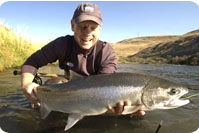Spey Page | Page Six
|
| Page 6 of 6 - 1 2 3 4 5 6 |
| Articles...
Short Sink-tips and Cheaters
Some of the best West Coast and Great Lakes steelhead guides we know like to fish short sink-tips for specific fishing situations. A 12’ tip will have a tendency to hang up when fishing boulder gardens. This is especially true when fishing soft winter water with massive rocks. Another scenario is during times of high, off-colored water and the fish are holding tight to the shore. A longer tip will often find the bottom on the inside of the swing. Many Great Lakes’ rivers and smaller West Coast rivers just don’t require a long sink-tip. Problem is, if you have a sink-tip of seven feet, you have changed both the length and grain weight significantly. Plus, a short sink-tip becomes really difficult to cast. There just isn’t enough fly line on the water to anchor the Spey cast. Enter the Rio Skagit Cheater. Cheaters come in lengths of 2’ ½ , 5’, and 7’ ½ in both floating and intermediate densities. In order to obtain the proper grain weight and length, you can add a “Cheater” between the Skagit head and the sink-tip. By doing so, you can fish shorter sink-tips without having to change your casting stroke. To give you an example, lets say your heaviest sink-tip for your 13’6 for a #8 weight Spey rod is 12’ of Rio T-14. (168 grains) A 7’ sink-tip of Rio T-14 weighs 98 grains. If you add a 5’ Skagit Cheater that weighs 65 grains (7/8/9), you will end up with an over-all length of 12’ weighing 163 grains total. You have stayed within your preferred length and sink-tip grain window.
The Perfect Spey Set-up for Steelhead
We asked the steelhead guides associated with this website what the most popular Spey rods were in there boats for both summer and winter fishing. A 13’ to 13’6 for a #7 weight rod seamed to be the average stick most clients show up with. Some good examples are the Sage 7136-4 Z-Axis, the Winston 7133-4 BIIx, the Burkheimer 7133-3, and the Echo 7130-4 TR. We asked them what sink-tips they would want for a #7 weight in both winter and summer.
Here it is…
Most used sink-tip:
12’ of Rio T-11 (132 grains) or Airflo CCT200 (120 grains)
Other sink-tips:
12’ of Rio #10 weight Type 3 (103 grains)
12’ of Rio #10 weight Type 6 (103 grains)
7’ of Rio T-14 with a 2 ½ (6/7/8) Rio Skagit Cheater (132 grains total)
The last sink-tip/cheater combo does bring up a good point. While we stayed within the preferred grain weight of our heaviest sink-tip (12’ of T-11 at 132 grains), we ended up with a 9 ½’ sink-tip. What gives? Sometimes you have to compromise length to stay under your maximum grain weight. If we added a 5’ cheater on this #7 weight, we would have overloaded the rod. As a general rule, grain weight will trump length.
If you know the river you’re going to be fishing requires heavier and longer sink-tips than your seven weight can handle, you might consider packing a #8 or #9 weight rod instead of the #7 weight. To see what professional guides fish on the best steelhead rivers in the country, check out the Steelhead Guides page. Each guide page has recommended gear for their fisheries.
Hopefully we’ve given you some insights into selecting the right sink-tip for your Spey rods and Skagit lines without confusing the hell out of you. If you have any other questions, please feel free to give us a call or shoot us an email.
-SB
| Page 6 of 6 - 1 2 3 4 5 6 |
|
|
|
|


